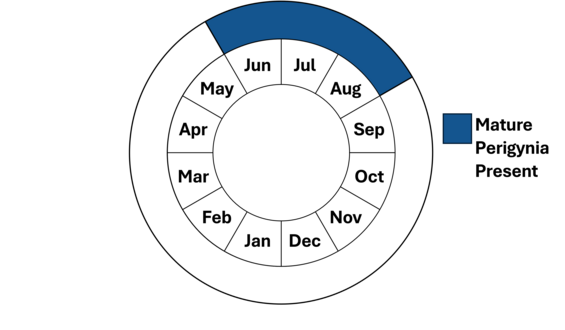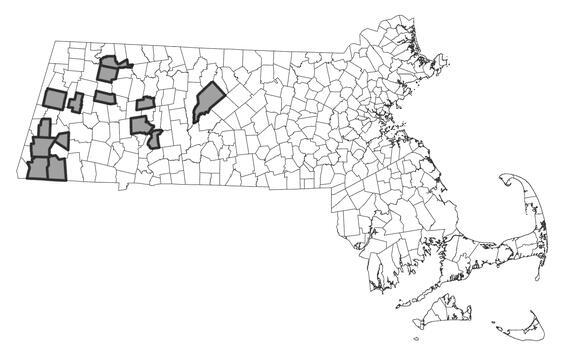- Scientific name: Carex tuckermanii
- Species of Greatest Conservation Need (MA State Wildlife Action Plan)
- Endangered (MA Endangered Species Act)
Description
Tuckerman’s sedge (Carex tuckermanii) is a perennial wetland sedge (family Cyperaceae), named for American lichenologist and botanist Edward Tuckerman (1817-1886). It grows in loose clumps, with erect to arching stems and linear leaves up to a meter in height in habitats such as river and lake shores, swamps, and vernal pools. This species, a member of the Carex section Vesicariae, has particularly distinctive female flowering spikes; the clusters of pendulous, inflated teardrop-shaped perigynia (sing., perigynium) are its most recognizable feature. A technical key is required to ensure correct identification.
Tuckerman’s sedge is a clump-forming plant with short rhizomes and triangular culms (reproductive stems). The leaves are typically flat and slender, usually 2-5 mm (0.08-0.2 in); the basal sheaths are reddish purple. Like other sedges in Carex section Vesicariae, Tuckerman’s sedge has staminate and pistillate spikes borne on separate spikes of each culm; the staminate spikes in this species are terminal. The pistillate spikes comprise cylindrical rows of ascending perigynia that often droop from slender stalks in a pendulous fashion. The perigynia (mostly 4.5-7 mm; 0.18-0.28 in wide), are broadly elliptic with prominent veins at the base, tapering to a double-toothed beak; and in flower are yellowish-green, later becoming straw-colored at maturity.
The pistillate scale is narrowly egg-shaped with a pointed tip and smooth margins. The achenes of this species are asymmetrical in shape with an indentation on one surface. The pistillate spike is subtended by a leaf-like bract (25–70 cm; 1-2.8 in long) that significantly exceeds the inflorescence. Mature perigynia are present throughout much of the summer.
Blister sedge (Carex vesicaria), another wetland species of section Vesicariae with ascending perigynia is similar to Tuckerman’s sedge but is more common; this species has smaller perigynia (shorter and narrower) than the rare species, and has a symmetrical achene, lacking an indentation. Several other species of Carex have inflated perigynia (including some of section Lupulinae and other species of section Vesicariae) and may superficially resemble Tuckerman’s sedge; thus numerous defining characters must be examined closely using a botanical key.
Life cycle and behavior

Sedges of the genus Carex have small unisexual wind-pollinated flowers borne in spikes. The staminate (male, pollen-bearing) flowers are subtended by a single flat scale; the pistillate (female, ovule-bearing) flowers are subtended by one flat scale (the pistillate scale) and are enclosed by a second sac-like modified scale, the perigynium. Following flowering, the achene (a dry, indehiscent, one-seeded fruit) develops within the perigynium. The morphological characters of these reproductive structures are important in identifying plants of the genus Carex to species.
Population status
Tuckerman’s sedge is listed under the Massachusetts Endangered Species Act (MESA) as Endangered. All listed species under MESA are protected from killing, collecting, possessing, or sale and from activities that would destroy habitat and thus directly or indirectly cause mortality or disrupt critical behaviors. The MassWildlife’s Natural Heritage & Endangered Species Program database has 21 records from 5 counties: Berkshire, Franklin, Hampshire, Middlesex, and Worcester. 14 of these records have been observed within the last 25 years.
Distribution and abundance
Tuckerman’s sedge is known from eastern and central Canada (New Brunswick, Nova Scotia, Quebec, Ontario), most of the northeastern and mid-Atlantic states south to Maryland and West Virginia; and into the Midwest (primarily the Great Lakes region) as far as Minnesota. It has been possibly extirpated in Iowa.

Distribution in Massachusetts
1999-2024
Based on records in the Natural Heritage Database
Habitat
In Massachusetts, Tuckerman’s sedge inhabits the rich soils of lowland river floodplain habitats such as oxbows (C-shaped wetlands adjacent to river channels), low depressions, forests, meadows, swales, and vernal pools. Associated species include fringed sedge (Carex crinita), hop-sedge (Carex lupulina), and sensitive fern (Onoclea sensibilis). The non-native plant moneywort (Lysimachia nummularia), an invasive, is sometimes associated with Tuckerman’s sedge.
Healthy habitats are vital for supporting native wildlife and plants. Explore habitats and learn about conservation and restoration in Massachusetts.
Threats
The Massachusetts populations that have persisted over time are found in low depressions or swales within forested river floodplains; the species apparently thrives despite periodic inundation, and flooding is an important dispersal mechanism. Thus, changes to the hydrologic regime due to local land use change could threaten the viability of a Tuckerman’s sedge population. Changes to water quality and competition with invasive plants are also a threat.
Conservation and management
The exact management needs of Tuckerman’s sedge are not known. As with all species, however, maintaining habitat quality is essential. Natural hydrologic cycles and water quality should be preserved; water quality degradation due to inputs of nutrients from fertilizers or animal waste could change the water and soil chemistry, and favor establishment of exotic or aggressive generalist species. Tuckerman’s sedge habitat should be monitored for exotic invasive species. Invasive plants can out-compete native plants for nutrients and light, excluding them over time. Some invasive plants, such as garlic mustard (Alliaria petiolata) are allelopathic, meaning they can change the soil chemistry to inhibit the viability of native plants. Exotic species of concern in flood plain communities include common reed (Phragmites australis ssp. australis), garlic mustard, purple loosestrife (Lythrum salicaria), moneywort, and reed canary grass (Phalaris arundinacea). If exotic plants are invading Tuckerman’s sedge habitat, a plan for control should be constructed. All active management within the habitat of a rare plant population (including invasive species removal) is subject to review under MESA and should be planned in close consultation with MassWildlife’s Natural Heritage & Endangered Species Program.
Contact
| Date published: | April 9, 2025 |
|---|